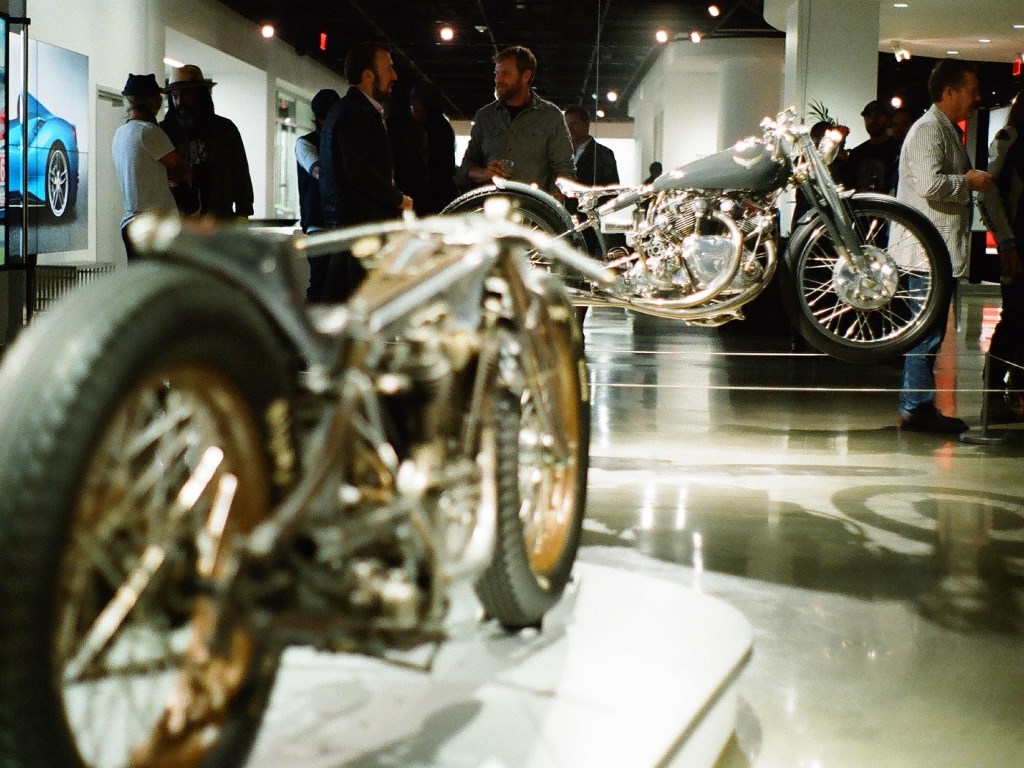‘Custom Revolution’ Rolls into Petersen Automotive Museum

New wave custom bikes from all over the world steal the show on opening night at famous L.A. venue.
The mainstream came to accept motorcycles as legitimate art with the Guggenheim’s landmark “Art of the Motorcycle” exhibit 20 years ago. Since then we have had a wave of TV choppers, a flood of home-built cafe racers, and top-tier classic bike shows that rival the classiest car concourse events. New bike sales may be down, but people who are not afraid to get their hands dirty are doing interesting things with used bikes, for display at the Handbuilt Show, the OG Motoshow, Born Free, and the like. And last week, the Petersen Automotive Museum in Los Angeles opened a new, year-long exhibit, “Custom Revolution,” that collects some of the standouts of this new wave custom scene from all over the world.
Hanging front and center in the exhibit space is Ian Barry‘s Vincent Black Shadow-based work of art, “The Black.” Crafted over the course of more than a year in 2011, the bike started with a former land speed-racing Vincent, in “barn find” condition. Starting with the cast steering neck and a motor, Barry handcrafted virtually every piece of the bike. Even the bits that look stock, like the fork, were remade by hand to look and work better. This isn’t just a static sculpture though. Engineered into the bike is the ability to go from stripped-down race mode to relaxed street mode with just a few twists of hand-machined thumbscrews, and adjustments of the controls. Everywhere you look, on all of Barry’s bikes, not just the Vincent, are machined details that will blow you away, like the “f” for Falcon Motorcycles machined into a valve cover plug.
No less intricate, but embracing a completely different aesthetic, is Shinya Kimura‘s Chabot Engineering 1914 Excelsior. Described as embracing the “wabi-sabi” philosophy of beauty in imperfection, Kimura is famous for building his bikes from rough, asymmetrical, mismatched parts and finishes. With a lesser builder, these pieces would combine to create a rat bike or worse, but with an artist’s eye and an engineer’s mind, they come together into modern machine art. And if you go out to El Mirage or Bonneville, you may see the artist actually riding them at speed, as well.
These two were not the only V-twin-powered bikes on display, with Harley-Davidson, Indian, Ducati, and even Royal Enfield represented. You didn’t know Royal Enfield made a V-twin? They don’t, but a very determined man from India named Aniket Vardhan does. His project to produce the Musket motor is a story in itself, but the Musket 2 custom by Max Hazan is what we are talking about here. Every bit as beautifully turned out, and handcrafted at Ian Barry’s bike shop, the Musket is simpler and less adorned. You can’t call something this polished “minimalist,” especially when you get close enough to see the details. But it has been engineered to look like there is less to it than there is. There are no visible control cables, wires, or switches, despite there seeming to be nowhere to hide them.
The most interesting Harley-Davidson on display came from a builder out of Germany, Uwe Ehinger of Ehinger Kraftrad, and it has a most interesting inspiration: Speedway. Speedway racing is an even simpler form of flat track, pitting four to six racers against each other for a handful of laps from a standing start around a dirt oval. The bikes are simple, with one speed, no brakes, and little suspension, and the action is fierce. The bikes and the riders tend to be flashy, and the fans are up close cheering them on. The Speedster features the lower end of a flathead (likely a WLA or Servicar model) with the top end of a Knucklehead grafted on, which is a magic trick unto itself. Then the hardtail frame and springer front end are added, finished with the metalflake and disc wheel common to speedway machines.
In all, there are only about two dozen bikes on display in the bike specific gallery that holds the exhibit, but you could stare at each one for half an hour and still find cool details. Most of them are mounted on raisers, putting them much closer to eye level, and giving you an look you’d have to get on your knees to see at a normal show. The guest curator for the show is Paul D’Orleans of the Vintagent, and he worked hard to bring in the bikes from around the world that you’ve probably been ogling online. Most of these bikes have been photographed thousands of times already, but images just can’t do justice to these 3-D works of art — you need to see them in the metal.
The best thing about this show of awesome customs is that unlike a lot of shows we report on, this one is sticking around. If you are in Los Angeles anytime within the next year or so, plan on stopping by the Petersen Automotive Museum to check it out, as well as their current exhibits on lowriders, Porsches, Ferraris, kiddie cars, and more.
Photos for Harley-Davidson Forums by Bryan Wood



































